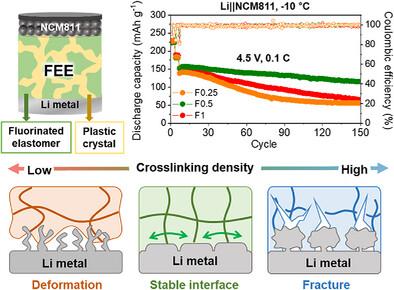Effects of Mechanical Properties of Elastomeric Electrolytes for Stable Operation of Lithium Metal Batteries
IF 26
1区 材料科学
Q1 CHEMISTRY, PHYSICAL
引用次数: 0
Abstract
The mechanical properties of polymer electrolytes are critical for the stable operation of lithium metal batteries (LMBs), as they accommodate volume changes of the lithium (Li) metal anode, suppress dendrite formation, and maintain interfacial stability. Here, we present a systematic investigation into the role of the mechanical characteristics of fluorinated elastomeric electrolytes (FEEs) in enabling stable cycling of LMBs at ambient and low temperatures. The FEEs consist of bicontinuous elastomer and plastic crystal phases, allowing independent control of mechanical properties by adjusting the crosslinking density of the elastomer phase. Concurrently, FEEs retain the fast ion transport properties of the plastic crystal phase, exhibiting high ionic conductivity of ≈1.1 and ≈0.24 mS cm−1 at 25 and −10 °C, respectively. The optimized FEE demonstrates balanced toughness (140.6 kJ m−3) and adhesion energy (31.4 J m−2), along with elastic recovery characteristic, enabling a Li|| LiNi0.8Co0.1Mn0.1O2 full cell to deliver a high initial discharge capacity (153 mAh g−1) with 76% capacity retention after 150 cycles at −10 °C. In contrast, lightly crosslinked FEEs undergo irreversible plastic deformation and loss of interfacial contact, while excessively crosslinked systems suffer from low toughness and are prone to fracture, both resulting in poor cycling performance.

弹性电解质力学性能对锂金属电池稳定运行的影响
聚合物电解质的力学性能对锂金属电池(lmb)的稳定运行至关重要,因为它们可以适应锂金属阳极的体积变化,抑制枝晶的形成,并保持界面稳定性。在这里,我们提出了一个系统的研究,氟化弹性体电解质(FEEs)的机械特性在使lmb在环境和低温下稳定循环中的作用。该材料由双连续的弹性体和塑性晶体相组成,可以通过调节弹性体相的交联密度来独立控制机械性能。同时,FEEs保持了塑料晶体相的快速离子传输特性,在25°C和- 10°C下分别表现出≈1.1和≈0.24 mS cm - 1的高离子电导率。优化后的FEE具有平衡的韧性(140.6 kJ m−3)和粘附能(31.4 J m−2),以及弹性恢复特性,使Li|| LiNi0.8Co0.1Mn0.1O2充满电池在- 10°C下循环150次后提供高初始放电容量(153 mAh g−1),容量保持率为76%。相比之下,轻度交联的体系会发生不可逆的塑性变形和界面接触损失,而过度交联的体系韧性低,容易断裂,两者都导致循环性能差。
本文章由计算机程序翻译,如有差异,请以英文原文为准。
求助全文
约1分钟内获得全文
求助全文
来源期刊

Advanced Energy Materials
CHEMISTRY, PHYSICAL-ENERGY & FUELS
CiteScore
41.90
自引率
4.00%
发文量
889
审稿时长
1.4 months
期刊介绍:
Established in 2011, Advanced Energy Materials is an international, interdisciplinary, English-language journal that focuses on materials used in energy harvesting, conversion, and storage. It is regarded as a top-quality journal alongside Advanced Materials, Advanced Functional Materials, and Small.
With a 2022 Impact Factor of 27.8, Advanced Energy Materials is considered a prime source for the best energy-related research. The journal covers a wide range of topics in energy-related research, including organic and inorganic photovoltaics, batteries and supercapacitors, fuel cells, hydrogen generation and storage, thermoelectrics, water splitting and photocatalysis, solar fuels and thermosolar power, magnetocalorics, and piezoelectronics.
The readership of Advanced Energy Materials includes materials scientists, chemists, physicists, and engineers in both academia and industry. The journal is indexed in various databases and collections, such as Advanced Technologies & Aerospace Database, FIZ Karlsruhe, INSPEC (IET), Science Citation Index Expanded, Technology Collection, and Web of Science, among others.
 求助内容:
求助内容: 应助结果提醒方式:
应助结果提醒方式:


